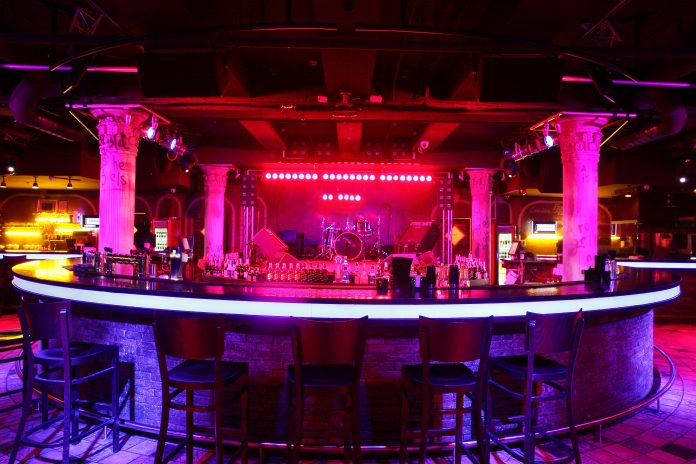(Note: This story appears in the January 2022 issue of ED Magazine)
Don’t miss these cleaning and maintenance tips for your club furniture!
Quality nightclub seating is an investment in your customers’ comfort and a way to keep them coming back. However, without proper club chair care, the wear and tear of daily use can take its toll on even the best commercial seating.
When you think of chair maintenance, the first thing that may come to mind is cleanliness. While each type and style of chair has its own specific instructions for cleaning, the appearance of the chair is only part of it.
In reality, the safety of your seating is just as important. All it takes is one accident with a rickety chair to hurt your club’s reputation, and “I’m not a furniture expert” is not a valid defense against a potential lawsuit.
It’s critical to your club’s success and reputation that you regularly clean and inspect your chairs. Knowing how to maintain your restaurant chairs will prolong the life of your seating and make sure that your customers are comfortable and safe as they enjoy their experience.
Cleaners: What to use and what to avoid
When you have hundreds of customers coming through your restaurant on a daily basis, accidents will happen. There’s no time to cry over spilled milk, water, cola, or anything else — it’s vital to the longevity of your chairs to clean up spills immediately.
One big assumption nightclub owners make is that all cleaners are created equal. However, different types of chairs and their various finishes, fabrics, and upholsteries have different needs, and the wrong type of cleaner could have disastrous effects.
There’s no room for shortcuts or attempts to do double duty with your cleaners. A cleaner that removes stains on one type of fabric or finish could strip the color or varnish on another, ruining the seating you’ve invested so much money in. It’s worth taking the extra time to clean different kinds of chairs with the right solutions or products.
The best part? The recommended cleaning products are simple and inexpensive–and you probably already have some of them.
How to clean wood seating
Use: A mixture of warm water and dish soap
How to clean: Wipe the surface gently with the soap and water mixture anad thoroughly dry when finished.
Avoid any citrus-based products, which can strip the finish.Every 3 months, use a furniture polish specifically designed for the chair’s type of finish. Do not change brands between cleanings as this can cause the wood to take on a cloudy appearance.
Dust the chairs regularly by wiping against the grain with a dry cloth. Treat your chairs with a paste wax every 3-4 months. This can help to disguise small scratches and minor damages.
Use a small amount of ammonia to remove spots or burns. Be sure to spot test first to make sure the finish will not be damaged. Use paste wax and steel wool to remove water rings. Again–be sure to spot test first.
How to clean metal seating
Use: Any non-abrasive household cleaning product, or mild soap and water
How to clean: Spray the solution on the surface and wipe dry with a clean cloth
Do not allow the cleaner to dry on the surface. This can damage the finish, causing the metal to easily chip or scratch. Use a soft-bristled brush to remove dirt buildup. Avoid any abrasive brushes, which can scratch or damage the metal. Mild soap and water works best to remove grease spots.
How to clean vinyl seating
Use: Mild soap and water
How to clean: Wipe down surfaces regularly with the solution
How to clean fabric and upholstery
Use: A dry towel and vacuum attachment
How to clean: Use the towel to blot up spills and vacuum dirt and dust off the surface.
The most important thing you can do for fabric and upholstery is to treat it with a stain guard before using the chairs. Sometimes this is done for you at the factory, but you also may have to do it yourself.
How to clean plastic
Use: Any non-abrasive household cleaning product, or mild soap and water
How to clean: Spray the solution on the surface and wipe dry with a cloth.
One big assumption nightclub owners make is that all cleaners are created equal. However, different types of chairs and their various finishes, fabrics, and upholsteries have different needs, and the wrong type of cleaner could have disastrous effects.
Chair maintenance made easy
Choosing the right cleaning solution is only part of restaurant chair maintenance. Caring for your seating and making sure it is safe and in good condition requires you to pay attention to other factors as well.
For upholstery or fabric, follow any specific directions for cleaning provided by the manufacturer to avoid damaging the product. If you need to spot test a particular cleaning product, always test an area that isn’t noticeable to customers.
Do not use any sharp tools or objects that could cause damage to your chairs. Clearly, avoiding abrasive cleaning products is critical to protecting your furniture, especially wood and metal chairs. However, this same rule applies to other abrasive tools like sandpaper and hard bristle brushes.
If you don’t know what type of cleaner would work best for your type of chair, go for soap and water to be on the safe side. Check the screws on chairs once a month and tighten any that are loose. If you notice any defects, immediately take the chair out of use and contact the manufacturer.
Maintenance instructions for your staff
Cleaning and maintaining your club seating is too big of a job for one person and the bulk of this task will ultimately fall to your employees. Once you decide what cleaners and maintenance processes work best for your chairs, you’ll need to instruct them on not just the correct cleaning procedures, but other requirements for keeping your chairs in good condition.
First, teach your employees the correct way to move chairs. Chairs should always be lifted and carried from one location to another, never dragged across the floor. Dragging can damage the legs of the chair as well as your floor and increases the likelihood of scratching.
Similarly, if you have hard floors, employees will need to move the chairs out of the way before cleaning the floors. This is because the cleaning products you use for the floor may not be compatible with the materials the chairs are made of. This could cause staining, clouding, or other damage to the furniture.
Finally, employees should wipe down, vacuum, or clean all seating at closing according to the above cleaning instructions to keep dust and dirt from accumulating. During this process, they should immediately notify management of any instability or damage they notice.
Replacement: Knowing when to say when
No matter how diligent your restaurant’s staff is with maintaining your chairs, the day will inevitably come when you need to replace them. Being able to tell when it’s time to retire old seating is an important point of how to maintain restaurant chairs for the safety and comfort of patrons.
Sign #1: You’re still using residential furniture
Please tell us you’re not using residential furniture. But if you are … continuing to use non-commercial furniture will put your customers’ safety at risk. This is because residential furniture is simply not built for the wear and tear sustained every day from customers. It wears out more quickly, and even with the best care, it will reach a point where it becomes an accident waiting to happen.
Sign #2: Your chairs show signs of minor rips, cracks, and splintering
These damages may seem small, but they nonetheless pose a threat to customers. The last thing you want is one of your patrons getting a cut or splinter because of a damaged chair.
While many of these smaller defects can be repaired, multiple signs of wear and tear may demonstrate that it’s time to replace them.
Sign #3: The chairs are wobbly and tightening the screws no longer works
Normally, tightening the screws on a chair should be enough to stop any wobbling, but if you reach a point where this solution no longer works, it may be time to order newer, safer chairs. As mentioned earlier, an accident with a broken chair could be catastrophic to your business.
Sign #4: The chairs look dirty or dingy even after being thoroughly cleaned
If your chairs look old or the fabric appears dirty or faded and cleaning no longer helps, your seating may need to be replaced with something brighter and newer.
Sign #5: You simply need to update your club’s look
To stay competitive, all clubs reach a point of needing to reinvent themselves or rebrand, and new seating will almost certainly be a part of this process.





























